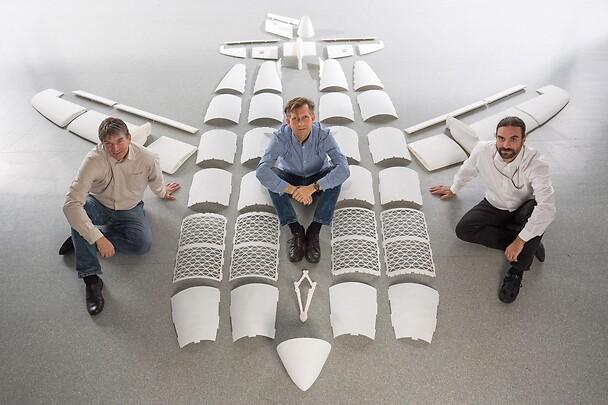
PPG’s senior group leader for additive manufacturing, Cindy Kutchko, and OEM segment manager for aerospace coatings and sealants, Duane Utter reveal how the company’s patented ambient reactive extrusion (ARE) technology is being used to make flight ready parts right off the printer.
PPG recently announced a partnership with Lockheed Martin to supply sets of six custom-designed ramp seals for the aft loading ramp of the C-130J Super Hercules military tactical airlifter. The partnership marks the creation of PPG’s first commercial product using its patented ambient reactive extrusion (ARE) technology called PPG ARE that results in easy-to-install parts made from PPG’s production qualified aerospace sealant. This process enables PPG to customise the design of various parts for continuous process improvement while increasing sustainability.
Q) Firstly, bring me up to speed with your latest additive manufacturing-related news?
PPG is currently working with Cosine Additive, our 3D printer equipment manufacturer for our additive manufacturing purposes. We’re interested in developing beta programmes in which a PPG representative works alongside Cosine Additive to develop new 3D printed components for our customers. Furthermore, we have installed a production scale 3D printer at our Application Support Centre (ASC) in Los Angeles to print parts up to 5’ x 10’.
Q) What are the types of trends and demands placed on your company by today’s aerospace customers?
PPG’s aerospace division has a network of 16 ASCs across the globe that are key to providing one worldwide source of customer support. These ASCs are conveniently located in areas that offer global capabilities from a regional base, which improves delivery of our products and brings technical resources close to our customers. We have sales staff on-hand to address any customer service inquiries. We’re also able to take on customised prototyping and end use parts with our 3D printed manufacturing capabilities.
As for customer demands, we are always working toward a reduction of cycle time and ways to efficiently customise gaskets, seals and other vehicle components and industrial parts. We are constantly striving to help creatively solve our customers’ problems, while finding ways to lightweight our products and be time and cost efficient.
Q) Please explain your patented ARE additive manufacturing technology process for producing flying parts?
As a coatings company, PPG has decades of polymers and formulation expertise to produce fully formulated, qualified products that meet customer specifications. This now includes the 3D printing process to produce parts. PPG’s patented ambient reactive extrusion process (PPG ARE) comprises a two-component liquid technology. When mixed and deposited onto a build plate, we are able to produce a thermoset part using qualified aerospace materials.

The technology is cured ambiently - no external energy is needed in the process and there is no thermal warping. We can dial in and improve the surface finish to ensure a smooth final product. In addition, due to our thermoset technology, we can create multi-material parts with covalent/chemical bonding throughout that can contain flexible, foam and even rigid parts, all covalently bonded together.
Q) How ‘robust’ are the aerospace parts you’re printing?
PPG’s 3D printed parts are extremely robust. Printing with a thermoset technology introduces covalent bonds, layer by layer, that produce a high strength part in the ‘z’ direction. The parts being printed are not currently used in and around the engine area, however, this chemical-resistant material can be used on many parts of the aircraft.
PPG is continually developing 3D-printable materials to address new opportunities. Temperature is a factor when creating these parts, since they can be exposed to a wide range of varying degrees. Currently, PPG’s additive manufacturing capabilities enable us to 3D print parts that can withstand a temperature range of -80ËF up to 420ËF. This technology is extremely well-suited to print large scale due to the liquid reactive technology designed by PPG. In addition, PPG’s ARE 3D technology can print features as small as 0.5mm to 1mm via flexible materials. PPG is currently developing further technologies to enable more drastic overhang features.
Q) Typically, what kinds of cycle time and cost reduction opportunities are we looking at over traditional manufacturing techniques?
Depending on the CAD design, our liquid extrusion technology can print 10 times faster than traditional thermal extrusion technologies, while imparting improved surface finishes due to the liquid nature. With no need for additional heat, our ambiently produced parts do not warp or separate due to thermal gradients common among thermal extrusion technologies.
In general, our PPG ARE technology provides cost savings of more than 30% that is verified with certain customers, but each would be unique. No external energy is needed so you also save money from an energy standpoint.
Q) Do you have a success story you can relate without breaking any NDAs?
We recently collaborated with the Carnegie Science Centre, located in Pittsburgh, PA along with PPG’s global headquarters, to develop a 3D-printed, scaled model of the Stanley Cup, hockey’s highest honour. This is part of the Carnegie Science Centre’s “Science on the Road” STEM outreach programme. The model was 3D printed using a different material than the sealants used for the Lockheed Martin C-130J Super Hercules ramp seals, but showcased PPG’s capabilities in developing fine features for a 3D printed article.
Q) Finally, how mature is the current aerospace additive manufacturing supply chain, and is the PPG ARE process a viable way forward for ‘flight ready’ part production?
PPG is a global corporation with many manufacturing sites around the world, so we are well-positioned for scale-up of aerospace-qualified materials. Since we’ve been producing aerospace sealants for many decades, our supply chain is very mature and we have begun expanding our 3D printing capabilities. The 3D printed parts we manufacture for Lockheed Martin’s C-130J Super Hercules require no post-processing and are ‘flight ready’ right off the printer.